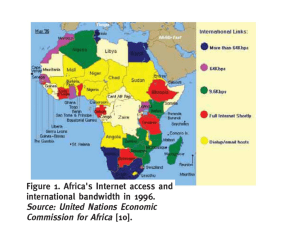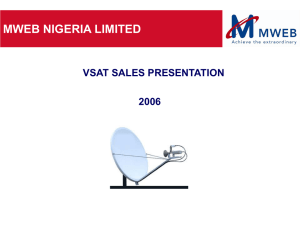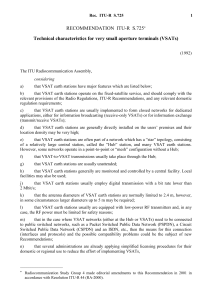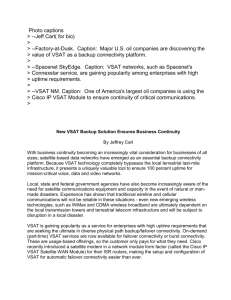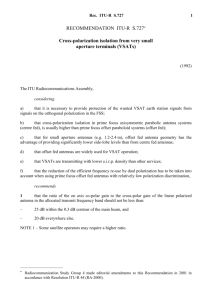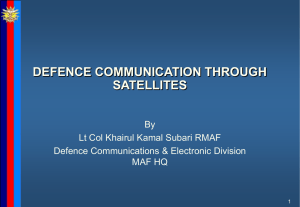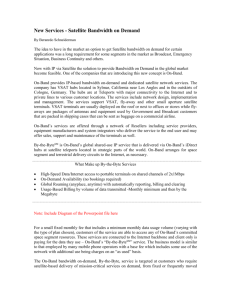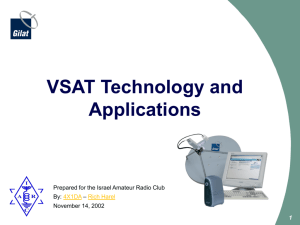Data Communications through Satellites – a VSAT Perspective
advertisement
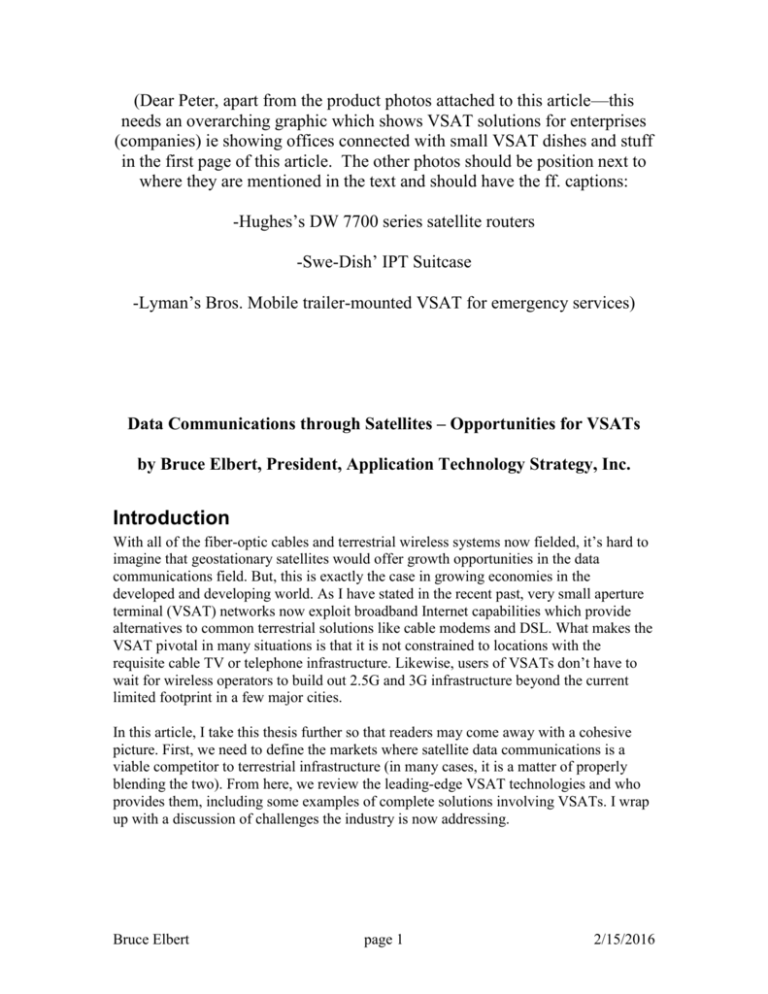
(Dear Peter, apart from the product photos attached to this article—this needs an overarching graphic which shows VSAT solutions for enterprises (companies) ie showing offices connected with small VSAT dishes and stuff in the first page of this article. The other photos should be position next to where they are mentioned in the text and should have the ff. captions: -Hughes’s DW 7700 series satellite routers -Swe-Dish’ IPT Suitcase -Lyman’s Bros. Mobile trailer-mounted VSAT for emergency services) Data Communications through Satellites – Opportunities for VSATs by Bruce Elbert, President, Application Technology Strategy, Inc. Introduction With all of the fiber-optic cables and terrestrial wireless systems now fielded, it’s hard to imagine that geostationary satellites would offer growth opportunities in the data communications field. But, this is exactly the case in growing economies in the developed and developing world. As I have stated in the recent past, very small aperture terminal (VSAT) networks now exploit broadband Internet capabilities which provide alternatives to common terrestrial solutions like cable modems and DSL. What makes the VSAT pivotal in many situations is that it is not constrained to locations with the requisite cable TV or telephone infrastructure. Likewise, users of VSATs don’t have to wait for wireless operators to build out 2.5G and 3G infrastructure beyond the current limited footprint in a few major cities. In this article, I take this thesis further so that readers may come away with a cohesive picture. First, we need to define the markets where satellite data communications is a viable competitor to terrestrial infrastructure (in many cases, it is a matter of properly blending the two). From here, we review the leading-edge VSAT technologies and who provides them, including some examples of complete solutions involving VSATs. I wrap up with a discussion of challenges the industry is now addressing. Bruce Elbert page 1 2/15/2016 Demands of the Market It wasn’t that long ago that data communications was dominated by IBM’s proprietary mainframe systems, along with packet switched services based on the X.25 protocol and pockets of distributed systems such as Digital Equipment Corporation’s DECnet. Teleprocessing services through service bureaus and computer timesharing services also demonstrated that you didn’t have to own the mainframes and servers needed to perform the computation and data storage functions. As we all know, the Internet Protocol (IP) changed everything and the World Wide Web is more than a researcher’s tool. Literally every company, government and a high percentage of individuals have immediate on-line access to an every-expanding array of services, information and inter-personal communications options. Having outgrown dialup connectivity, users at all levels want and often can justify broadband access and backbone data communications based on IP. Add to this the new millions of telephone subscribers who have moved to VoIP services through an available broadband connection. On July 7th, 2005, the FCC published data on high speed services for Internet access in the US. It provides, in part, “During the year 2004, high-speed lines serving residential, small business, larger business, and other subscribers increased by 34%, to 37.9 million lines. The increase was 17% during the second half of 2004, from 32.5 million to 37.9 million lines, compared to a 15% increase, from 28.2 million to 32.5 million lines, during the first half of the year.” Extending at a rate of only 10% to July, 2005, produces a total of over 41 million high-speed lines. This is an astounding result when you consider that these are premium services compared to low-cost dial-up Internet access, which arguably could do the basic job for most people. In terms of geographic coverage, the FCC adds, “At the end of 2004, the service providers that report to the Commission had at least one high-speed service subscriber in 95% of the nation’s zip codes. Our analysis indicates that 99% of the country’s population lives in these zip codes.” Those who want and need high-speed Internet services want it now and they want it available wherever they are. This is clearly the domain of wireless Internet; but, wireless operators are not able to satisfy the same kind of cross section as do those that own landlines. This is because it is exceedingly complex, expensive and time-consuming to implement and extend high-speed IP services in the same manner as narrow-band voice services that are currently available almost anywhere people go. Where We Stand Technically VSATs have tremendous opportunities, provided they do the job with technical superiority and at a reasonable price. The technical performance of the current VSAT is, by any measure, excellent. No longer are applications constrained to the equivalent of a low-speed dial-up modem; rather, the baseline is broadband at megabit-per-second speeds. The underlying technologies that facilitate this include: DSP chips and software that implement the most sophisticated modulation and forward error correction schemes in commercial practice; solid-state power amplifiers at Ku and Ka band that are both affordable and reliable; multiple-access schemes based primarily on TDMA with Bruce Elbert page 2 2/15/2016 enhanced dynamic bandwidth control and mode-switching to match what users are actually doing at any particular time; better encryption security; and features for assigning priorities based on Quality-of-Service (QoS) objectives. Most VSAT systems employ the star architecture to simplify VSAT design and allow for multi-cast capabilities; this allows remote sites to access central resources and the global Internet with relative ease and near-transparency. Mesh networks, which permit direct remote VSAT-to-remote VSAT connections, have not caught on particularly well, although there are applications (e.g., video conferencing) that need the low-latency point-to-point connection that the mesh affords. Importantly, a license or technical training to use a VSAT is no longer needed as it is as easy to operate as a cable modem. The current offerings from leading manufacturers of VSATs all incorporate these desirable attributes, but differ in terms of specific capabilities and price-points. As I have said in the past, one needs to understand their requirements in order to evaluate and select from more than five different approaches. It is possible to sub-divide the field of starbased approaches according to the following five broad categories: 1. Consumer access to the Internet 2. Private (enterprise) networks 3. Leased-line (SCPC) replacement 4. Digital content distribution 5. Mobile communications Each of these approaches places different demands on the technical architecture of the VSAT, and consequently there are physical and electrical differences among them. The price of the associated equipment and satellite capacity likewise varies, more or less in concert with the value that the particular approach brings to the particular user segment. I believe it is possible to associate currently-available VSAT products with one or more of the five segments identified above. Please view these as suggestions and not endorsements. There is, after all, no substitute for doing your own due-diligence on the companies and products to assure yourself that the approach is a fit. Consumer Internet access demands simplicity, performance and low price. Of the current offerings, I suggest that the new DirecWay series of VSATs from Hughes Network Systems is a worthy example. DirecWay has evolved over the years, benefiting from the Hughes position of leadership in market share and experience. I would also like to point out that ViaSat has begun delivering the SurfBeam VSAT for the WildBlue broadband service in the US. Surfbeam will give us a good “taste-test” for cable-modem service in the sky. From a private network perspective, I have observed that very capable VSAT systems are available from several companies that have adopted the DVB-RCS standard. Included here are, again, ViaSat with LinkStar, EMS and Nera. I will address the issue of standards and inter-operability (for multi-vendor networks) later in this artlcle. In addition the DVB-RCS “family”, it is also important to give mention to the Hughes DW 7700 series just announced (reviewed in a case study and the conclusion, below). Private Bruce Elbert page 3 2/15/2016 networks from Gilat, featuring good service at reasonable cost, are popping up like mushrooms around Africa and South America, a testimony to Gilat’s resolve to address a here-to-fore ignored market. This brings us to venerable role of point-to-point links over satellite, used for private lines for Frame Relay, telephone trunks and to tie remote Internet service providers to the global backbone. Single-channel per carrier (SCPC) links, which are permanently assigned, have been a reliable means of accomplishing the result, but they are costly in terms of satellite bandwidth costs which are fixed per month regardless of usage. This is where the broadband VSAT products from iDirect have taken root. The fact that iDirect has seen explosive growth in their sales in the last few years is a testimony to how well engineered this product is. They have received industry awards from the World Teleport Association, SSPI, and recently at the ISCe Conference. Addressing content distribution, this is generally a one-way multi-cast proposition using the DVB-S standard along with content authoring and management servers and software. Two companies stand out, in my view – Skystream Networks and Sony. Skystream pioneered the advance IP encapsulator and Edge Router to provide the point-to-point means of pushing the content from hub to remote site. On top of this, they offer a software system called zBand that allows efficient scheduling of content delivery and assures that all files and data get where they are supposed to. Sony provided their plasma displays and a specialized multimedia player that integrates real-time video with files and information delivered by zBand. In the mobile arena, VSATs play a vital role of giving high speed access in what was previously a very low speed world. Examples abound in news gathering, disaster recovery, military special operations, and specialty markets such as oil and gas and construction management. A single-suitcase VSAT such as the Swe-Dish IPT and the SwiftLink DVM-100 from TeleCommunication Systems provide the unique ability to get broadband service on the air at Ku-band in just a few minutes. One cannot help but marvel at how Boeing put this capability into commercial jetliners, employing their own electrically-steered phased arrays and spread spectrum VSAT equipment from ViaSat. Companies like Stratos Global and CapRock have put these systems together to go on ships and drilling rigs, making it possible to deliver two-way broadband services on the oceans. Examples of Cutting-edge VSAT Solutions All of these technologies and services give the user and application developer effective tools in small packages. I will now offer some recent examples of how these tools play in the data communications world. FamilyMart. The third-largest convenience store chain in Japan has opened up operations in California. Under the Famima!! brand, Famima Corp has placed its first new lifestyle specialty all-in-one community store (Premium Grocer + Quick Service Restaurant + Convenience Store) on the corner of Santa Monica and La Cienega Boulevards in West Hollywood. To meet their tight schedule for an opening on July 20th, 2005, Famima Bruce Elbert page 4 2/15/2016 chose VSAT data communications to integrate all of their business services and to support an Internet café with wireless access. Working with JSAT International Inc., the US subsidiary of JSAT Corporation of Japan, Famima successfully brought up its first VSAT link in only one day. Supplied by Hughes Network Systems, the newly-introduced DW 7700 VSAT did its job with ample capacity and simplicity. Store operations that use the VSAT include credit authorization and point of sale, store inventory, accounting and Internet billing. Rollout of additional stores from here will be a piece of cake from a communications and data processing standpoint. Working with Fujitsu Consulting, the IT systems integrator for Family Mart, JSAT provided the most appropriate VSAT solution along with ISP services for the Internet Café. Safeway. Digital content distribution networks via satellite are still a small niche in the overall VSAT market. Many companies have been evaluating what, exactly, a digital CDN can accomplish for a grocery chain, bank or gas station. Safeway Stores was one of the first large retail enterprises to experiment with CDM technology. Growing out of a private broadcast and training network, their evaluation of CDN technology and business models included a live video network produced by ABC Television. This innovative system that I viewed in a Safeway store in San Jose, California, looked and sounded like something you would watch at home. The difference was that it focused on Safeway and the products available in the store I visited. The elements used in this network consisted primarily of what I described above from SkyStream and Sony. Forest Service. During critical situations, particularly with forest fires, the United States Forest Service has immediate communications needs. With base camps frequently being located as close to the incident as possible, land lines for voice and data use are not easily accessible. Lyman Bros., Inc., approached the Forest Service about the possibility of satellite data communications as a way of getting voice, fax and data services to the base camp to help incident management teams. This was accomplished by bringing in a VSAT terminal to the incident and running various voice and data lines throughout the base camp for phone and fax communication. Currently, Lyman Bros. uses a trailer mounted VSAT using iDirect technology to offer VoIP and broadband data services to forest fires throughout the West, continuing to meet the Forest Service’s communications needs. These examples demonstrate many of the features and technologies I discussed previously. Putting the pieces together involves a little creativity and knowledge. However, the fact that the tools are ready and affordable makes this a unique age of opportunity for VSATs. Challenges, Not Roadblocks, to Continued Development I feel it appropriate to round out this article by reviewing some challenges the industry and users face as VSATs attempt to gain prominence. I recently accepted the position of chairman of the Technology Working Group of the Global VSAT Forum. The charter of the TWG is to follow two areas of both challenge and opportunity – gaining and protecting satellite spectrum and assessing technical standards that could be a positive force for adoption of VSAT solutions. I will briefly describe each. Bruce Elbert page 5 2/15/2016 The question of assuring adequate frequency spectrum naturally involves the ITU World Radio Conferences (WRCs), where the trend toward higher satellite frequencies, smaller aperture antennas, a more congested orbital arc, and advocacy for frequency-sharing regimes (adding terrestrial services in heretofore satellite-only spectrum) has dramatically heightened the need for a unified industry voice. Some smaller ITU members may not now see much value in protecting satellite frequencies while others are being encouraged by terrestrial interests to allow new sharing rules for satellite spectrum. Countries most in need of data communications solutions would be ill advised to sell their satellite birthright for empty promises. It will come as no surprise that the theme of the most recent GVF Summit – proprietary and interoperable systems - continues to be an increasingly important subject for the industry worldwide. The DVB-RCS standard is now fait accompli, and hardware is selling at a fairly brisk pace. Likewise, Hughes Network Systems introduced a standard called IPoS to gain acceptance for their systems in the same context as DVB-RCS. The value of these standards could be in making VSATs more generic and less dependent on the performance of a single supplier. Consider, however, that some regulators in Latin America have been discussing the possibility of enacting national legislation that would require project bids involving satellite earth stations to demonstrate that they are interoperable. In addition to such techno-political considerations, the GVF will produce a technology summit, titled, “Today’s Technology and Standards” to examine approaches that have enabled service providers to respond to the needs of their customers in an effective manner. Anyone who has followed our industry for a few decades knows that challenges have come and with it the necessary innovation and action to move us ahead. The new TWG will be meeting for the first time in September at the IBC convention in Amsterdam where members are invited to help shape this agenda and contribute to its success. There are obviously other venues and groups who likewise want to see progress made. So, consider both the aforementioned capabilities of VSATs for data communications and the efforts needed to ensure that this future can be reached sooner rather than later. (pick-up Bruce Elbert’s bio from June issue) Bruce Elbert page 6 2/15/2016
